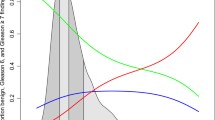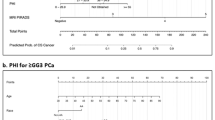Abstract
Purpose
Similar to prostate-specific antigen (PSA) density, PCA3 density (PCA3D: ratio of urinary PCA3 score/prostate volume) can be calculated, but whether it can be an aid to decide biopsy in patients at risk of prostate cancer (PCa) is uncertain. The objective was to demonstrate that PCA3D provides better specificity than PCA3 in predicting initial prostate biopsy outcome.
Methods
Serum and urine samples were obtained from 595 consecutive patients scheduled for initial prostate biopsy. The urinary PCA3 test was performed before biopsy. Additional measures were prostate volume, PSA density (PSAD) and PCA3D. Multivariate logistic regression models including baseline characteristics and the markers were evaluated. The presumed net benefit was assessed through decision curve analyses.
Results
PSAD and PCA3D performed better than PSA and PCA3 score, respectively. PCA3D provided the best specificity (76 %). The best calculated cutoff for PCA3D was 1. The risk of positive biopsy significantly increased to 70 % if PCA3D ≥ 1 versus 29 % if PCA3D was <1. Using a cutoff at 0.5 for PCA3D, biopsies could have been avoided in up to 52 % of the patients without PCa while missing 15 % of any PCa and 10 % of PCa with Gleason score ≥7. Decision curve analyses showed that PSAD was the best predictor of Gleason score at biopsy while PCA3D best predicted the proportion of invaded cores.
Conclusions
PCA3D showed a significant increase in specificity when compared with PSA, PSAD and PCA3. PCA3D can be considered an easy-to-use mini-nomogram with a 70 % risk of positive initial biopsy when PCA3D > 1, i.e., PCA3 score > prostate volume.

Similar content being viewed by others
References
Brawley OW (2012) Prostate cancer epidemiology in the United States. World J Urol 30(2):195–200. doi:10.1007/s00345-012-0824-2
Thompson IM, Pauler DK, Goodman PJ, Tangen CM, Lucia MS, Parnes HL, Minasian LM, Ford LG, Lippman SM, Crawford ED, Crowley JJ, Coltman CA Jr (2004) Prevalence of prostate cancer among men with a prostate-specific antigen level < or = 4.0 ng per milliliter. N Engl J Med 350(22):2239–2246
Hessels D, Klein Gunnewiek JM, van Oort I, Karthaus HF, van Leenders GJ, van Balken B, Kiemeney LA, Witjes JA, Schalken JA (2003) DD3(PCA3)-based molecular urine analysis for the diagnosis of prostate cancer. Eur Urol 44(1):8–15
Auprich M, Bjartell A, Chun FK, de la Taille A, Freedland SJ, Haese A, Schalken J, Stenzl A, Tombal B, van der Poel H (2011) Contemporary role of prostate cancer antigen 3 in the management of prostate cancer. Eur Urol 60(5):1045–1054
Vlaeminck-Guillem V, Ruffion A, Andre J, Devonec M, Paparel P (2010) Urinary prostate cancer 3 test: toward the age of reason? Urology 75(2):447–453
Groskopf J, Aubin SM, Deras IL, Blase A, Bodrug S, Clark C, Brentano S, Mathis J, Pham J, Meyer T, Cass M, Hodge P, Macairan ML, Marks LS, Rittenhouse H (2006) APTIMA PCA3 molecular urine test: development of a method to aid in the diagnosis of prostate cancer. Clin Chem 52(6):1089–1095
de Kok JB, Verhaegh GW, Roelofs RW, Hessels D, Kiemeney LA, Aalders TW, Swinkels DW, Schalken JA (2002) DD3(PCA3), a very sensitive and specific marker to detect prostate tumors. Cancer Res 62(9):2695–2698
Bussemakers MJ, van Bokhoven A, Verhaegh GW, Smit FP, Karthaus HF, Schalken JA, Debruyne FM, Ru N, Isaacs WB (1999) DD3: a new prostate-specific gene, highly overexpressed in prostate cancer. Cancer Res 59(23):5975–5979
Auprich M, Chun FK, Ward JF, Pummer K, Babaian R, Augustin H, Luger F, Gutschi S, Budaus L, Fisch M, Huland H, Graefen M, Haese A (2011) Critical assessment of preoperative urinary prostate cancer antigen 3 on the accuracy of prostate cancer staging. Eur Urol 59(1):96–105. doi:10.1016/j.eururo.2010.10.024
Durand X, Xylinas E, Radulescu C, Haus-Cheymol R, Moutereau S, Ploussard G, Forgues A, Robert G, Vacherot F, Loric S, Allory Y, Ruffion A, de la Taille A (2012) The value of urinary prostate cancer gene 3 (PCA3) scores in predicting pathological features at radical prostatectomy. BJU Int 110(1):43–49. doi:10.1111/j.1464-410X.2011.10682.x
Nakanishi H, Groskopf J, Fritsche HA, Bhadkamkar V, Blase A, Kumar SV, Davis JW, Troncoso P, Rittenhouse H, Babaian RJ (2008) PCA3 molecular urine assay correlates with prostate cancer tumor volume: implication in selecting candidates for active surveillance. J Urol 179(5):1804–1809
Ploussard G, Durand X, Xylinas E, Moutereau S, Radulescu C, Forgue A, Nicolaiew N, Terry S, Allory Y, Loric S, Salomon L, Vacherot F, de la Taille A (2011) Prostate cancer antigen 3 score accurately predicts tumour volume and might help in selecting prostate cancer patients for active surveillance. Eur Urol 59(3):422–429. doi:10.1016/j.eururo.2010.11.044
Vlaeminck-Guillem V, Devonec M, Colombel M, Rodriguez-Lafrasse C, Decaussin-Petrucci M, Ruffion A (2011) Urinary PCA3 score predicts prostate cancer multifocality. J Urol 185(4):1234–1239. doi:10.1016/j.juro.2010.11.072
Whitman EJ, Groskopf J, Ali A, Chen Y, Blase A, Furusato B, Petrovics G, Ibrahim M, Elsamanoudi S, Cullen J, Sesterhenn IA, Brassell S, Rittenhouse H, Srivastava S, McLeod DG (2008) PCA3 score before radical prostatectomy predicts extracapsular extension and tumor volume. J Urol 180(5):1975–1978
Siegrist TC, Panagopoulos G, Armenakas NA, Fracchia JA (2012) PCA3 permutation increases the prostate biopsy yield. Commun Oncol 9(8):243–246
Buderer NM (1996) Statistical methodology: i. Incorporating the prevalence of disease into the sample size calculation for sensitivity and specificity. Acad Emerg Med 3(9):895–900
Carley S, Dosman S, Jones SR, Harrison M (2005) Simple nomograms to calculate sample size in diagnostic studies. Emerg Med J 22(3):180–181. doi:10.1136/emj.2003.011148
Vickers AJ, Elkin EB (2006) Decision curve analysis: a novel method for evaluating prediction models. Med Decis Making 26(6):565–574. doi:10.1177/0272989X06295361
Epstein JI, Walsh PC, Carmichael M, Brendler CB (1994) Pathologic and clinical findings to predict tumor extent of nonpalpable (stage T1c) prostate cancer. JAMA 271(5):368–374
Bangma CH, Roemeling S, Schroder FH (2007) Overdiagnosis and overtreatment of early detected prostate cancer. World J Urol 25(1):3–9
Chevli KK, Duff M, Walter P, Yu C, Capuder B, Elshafei A, Malczewski S, Kattan MW, Jones JS (2013) Urinary PCA3 as a predictor for prostate cancer in a cohort of 3073 men undergoing initial prostate biopsy. J Urol. doi:10.1016/j.juro.2013.12.005
Hansen J, Auprich M, Ahyai SA, de la Taille A, van Poppel H, Marberger M, Stenzl A, Mulders PF, Huland H, Fisch M, Abbou CC, Schalken JA, Fradet Y, Marks LS, Ellis W, Partin AW, Pummer K, Graefen M, Haese A, Walz J, Briganti A, Shariat SF, Chun FK (2013) Initial prostate biopsy: development and internal validation of a biopsy-specific nomogram based on the prostate cancer antigen 3 assay. Eur Urol 63(2):201–209. doi:10.1016/j.eururo.2012.07.030
Ruffion A, Devonec M, Champetier D, Decaussin-Petrucci M, Rodriguez-Lafrasse C, Paparel P, Perrin P, Vlaeminck-Guillem V (2013) PCA3 and PCA3-based nomograms improve diagnostic accuracy in patients undergoing first prostate biopsy. Int J Mol Sci 1422–0067 14(9):17767–17780. doi:10.3390/ijms140917767. http://www.mdpi.com/1422-0067/14/9/17767
Ko JS, Landis P, Carter HB, Partin AW (2011) Effect of intra-observer variation in prostate volume measurement on prostate-specific antigen density calculations among prostate cancer active surveillance participants. BJU international 108(11):1739–1742. doi:10.1111/j.1464-410X.2011.10223.x
Sech S, Montoya J, Girman CJ, Rhodes T, Roehrborn CG (2001) Interexaminer reliability of transrectal ultrasound for estimating prostate volume. J Urol 166(1):125–129
Dianat SS, Rancier Ruiz RM, Bonekamp D, Carter HB, Macura KJ (2013) Prostate volumetric assessment by magnetic resonance imaging and transrectal ultrasound: impact of variation in calculated prostate-specific antigen density on patient eligibility for active surveillance program. J Comput Assist Tomogr 37(4):589–595. doi:10.1097/RCT.0b013e318296af5f
Tang P, Jin XL, Uhlman M, Lin YR, Deng XR, Wang B, Xie KJ (2013) Prostate volume as an independent predictor of prostate cancer in men with PSA of 10–50 ng ml(−1.). Asian J Androl 15(3):409–412
Al-Azab R, Toi A, Lockwood G, Kulkarni GS, Fleshner N (2007) Prostate volume is strongest predictor of cancer diagnosis at transrectal ultrasound-guided prostate biopsy with prostate-specific antigen values between 2.0 and 9.0 ng/mL. Urology 69(1):103–107
Stephan C, Stroebel G, Heinau M, Lenz A, Roemer A, Lein M, Schnorr D, Loening SA, Jung K (2005) The ratio of prostate-specific antigen (PSA) to prostate volume (PSA density) as a parameter to improve the detection of prostate carcinoma in PSA values in the range of < 4 ng/mL. Cancer 104(5):993–1003. doi:10.1002/cncr.21267
Scattoni V, Zlotta A, Montironi R, Schulman C, Rigatti P, Montorsi F (2007) Extended and saturation prostatic biopsy in the diagnosis and characterisation of prostate cancer: a critical analysis of the literature. Eur Urol 52(5):1309–1322
Acknowledgments
We thank Drs M. Vinet, J.L. Campos-Fernandes, Gobeaux, E. Adam, S. Genevoix, R. Lardon, P.E. Briant, C. De Vendin, F.X. Buttin, J.G. Lopez, S. Borgnat, A.C. Coste and M. Goris for their contributions in patient recruitment. We wish to thank Mrs. M. Cottancin and Miss B. Grangier for their excellent technical contribution and thank also M. J. Day for English editing.
Conflicts of interest
None.
Author information
Authors and Affiliations
Corresponding author
Electronic supplementary material
Below is the link to the electronic supplementary material.
Rights and permissions
About this article
Cite this article
Ruffion, A., Perrin, P., Devonec, M. et al. Additional value of PCA3 density to predict initial prostate biopsy outcome. World J Urol 32, 917–923 (2014). https://doi.org/10.1007/s00345-014-1251-3
Received:
Accepted:
Published:
Issue Date:
DOI: https://doi.org/10.1007/s00345-014-1251-3




